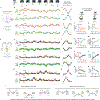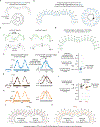Building an allocentric travelling direction signal via vector computation
- PMID: 34912112
- PMCID: PMC11104186
- DOI: 10.1038/s41586-021-04067-0
Building an allocentric travelling direction signal via vector computation
Abstract
Many behavioural tasks require the manipulation of mathematical vectors, but, outside of computational models1-7, it is not known how brains perform vector operations. Here we show how the Drosophila central complex, a region implicated in goal-directed navigation7-10, performs vector arithmetic. First, we describe a neural signal in the fan-shaped body that explicitly tracks the allocentric travelling angle of a fly, that is, the travelling angle in reference to external cues. Past work has identified neurons in Drosophila8,11-13 and mammals14 that track the heading angle of an animal referenced to external cues (for example, head direction cells), but this new signal illuminates how the sense of space is properly updated when travelling and heading angles differ (for example, when walking sideways). We then characterize a neuronal circuit that performs an egocentric-to-allocentric (that is, body-centred to world-centred) coordinate transformation and vector addition to compute the allocentric travelling direction. This circuit operates by mapping two-dimensional vectors onto sinusoidal patterns of activity across distinct neuronal populations, with the amplitude of the sinusoid representing the length of the vector and its phase representing the angle of the vector. The principles of this circuit may generalize to other brains and to domains beyond navigation where vector operations or reference-frame transformations are required.
© 2021. The Author(s), under exclusive licence to Springer Nature Limited.
Conflict of interest statement
Author Information
The authors declare no competing financial interests.
Figures















References
-
- Zipser D & Andersen RA A back-propagation programmed network that simulates response properties of a subset of posterior parietal neurons. Nature 331, 679–684 (1988). - PubMed
-
- O’Keefe J An allocentric spatial model for the hippocampal cognitive map. Hippocampus 1, 230–235 (1991). - PubMed
-
- Touretzky DS, Redish AD & Wan HS Neural Representation of Space Using Sinusoidal Arrays. Neural Comput. 5, 869–884 (1993).
-
- Pouget A & Sejnowski TJ A neural model of the cortical representation of egocentric distance. Cereb. Cortex 4, 314–329 (1994). - PubMed
Methods references
-
- Lin CY et al. A Comprehensive Wiring Diagram of the Protocerebral Bridge for Visual Information Processing in the Drosophila Brain. Cell Rep. 3, 1739–1753 (2013). - PubMed
-
- Reiser MB & Dickinson MH A modular display system for insect behavioral neuroscience. J. Neurosci. Methods 167, 127–139 (2008). - PubMed
-
- Maimon G, Straw AD & Dickinson MH A Simple Vision-Based Algorithm for Decision Making in Flying Drosophila. Curr. Biol. 18, 464–470 (2008). - PubMed
Publication types
MeSH terms
Grants and funding
LinkOut - more resources
Full Text Sources
Molecular Biology Databases
Miscellaneous

